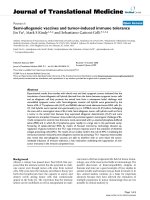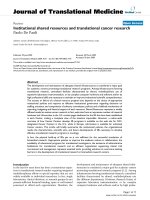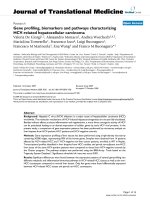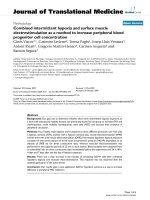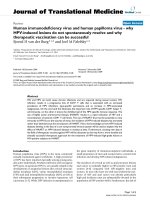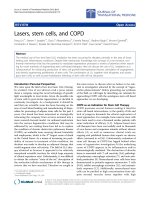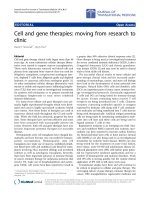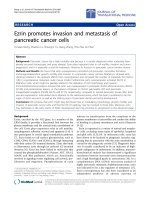Báo cáo hóa học: " Banach operator pairs and common fixed points in modular function spaces" pptx
Bạn đang xem bản rút gọn của tài liệu. Xem và tải ngay bản đầy đủ của tài liệu tại đây (333.24 KB, 12 trang )
RESEARCH Open Access
Banach operator pairs and common fixed points
in modular function spaces
N Hussain
1
, MA Khamsi
2
and A Latif
1*
* Correspondence:
sa
1
Department of Mathematics, King
Abdulaziz University, P.O. Box
80203, Jeddah 21589, Saudi Arabia
Full list of author information is
available at the end of the article
Abstract
In this article, we introduce the concept of a Banach operator pair in the setting of
modular function spaces. We prove some common fixed point results for such type
of operators satisfying a more general condition of nonexpansiveness. We also
establish a version of the well-known De Marr’s theorem for an arbitrary family of
symmetric Banach operator pairs in modular function spaces without Δ
2
-condition.
MSC(2000): primary 06F30; 47H09; secondary 46B20; 47E10; 47H10.
Keywords: Banach opera tor pair, fixed point, modular function space, nearest point
projection, asymptotically pointwise ρ-nonexpansive mapping
1. Introduction
The purpose of this article is to give an outline of fixed point theory for mappings
defined on some subsets of modular function spaces which are natural generalization
of both function and sequence variants of many important, from applications perspec-
tive, spaces like Lebesgue, Orlicz, Musielak-Orlicz, Lorentz, Orlicz-Lorentz, Calderon-
Lozanovskii spaces and many others. This article operates w ithin the framework of
convex function modulars.
The importance of applications of nonexpansive mappings in modular function
spaces lies in the richness of structure of modular function spaces that besides being
Banach spaces (or F-spaces in a more general settings) are equipped with modular
equ ivalents of norm or metric notions, and also are equipped with almost everywhere
convergence and convergence in submeasure. In many cases, particularly in applica-
tions to integral operators, approximat ion and fixed point results, modular type condi-
tions are much more natural as modular type assumptions can be more easily veri fied
than their metric or norm counterparts. There are also important results that can be
proved only using the concepts of modular function spaces. From this perspective, the
fixed point theory in modular function spaces should be considered as complementary
to the fixed point theory in normed spaces and in metric spaces.
The theory of contractions and nonexpansive mappings defined on convex subsets of
Banach spaces is rich (see, e.g., [1-4]) and has been well developed since the 1960s and
generalized t o other metric spaces (see, e.g., [ 5-7]), and modular function spaces (see,
e.g., [8-11]). The corresponding fixed point results were then extended to larger classes
of mappings like asymptotic mappings [12,13], pointwise contractions [14] and asymp-
totic pointwise contractions and nonexpansive mappings [15-17].
Hussain et al. Fixed Point Theory and Applications 2011, 2011:75
/>© 2011 Hussain et al; licensee Springer. This is an Open Access article distributed under the terms of the Creative Commons
Attribution License ( nses/by/2.0), which permits unrestricted use, distribution, and reproduction in
any medium, provided the original work is properly cited.
As noted in [16,18], questions are sometimes asked whether the theory of modular
function spa ces provides general methods for the consideration of fixed point proper-
ties; the situation here is the same as it is in the Banach space setting.
In this article, we introduce the concept of a Banach operator pair in modular func-
tion spaces. Then, we investigate the existence of common fixed points for such opera-
tors. Believing that the well-known De Marr’s theorem [19] is not known yet in the
setting of modular function spaces, we establish this classical result in this new setting.
2. Preliminaries
Let Ω be a nonempty set and Σ be a nontrivial s-algebra of subsets of Ω. Let
P
be a δ-
ring of subsets of Ω, such that
E ∩ A ∈
P
for any
E ∈
P
and A Î Σ. Let us assume that
there exists an increasing sequence of sets
K
n
∈ P
such that Ω =UK
n
.By
E
we denote
the linear space of all simple functions with supports from
P
.By
M
∞
we will denote
the space of all extended measurable functions, i.e., all functions f : Ω ® [- ∞, ∞] such
that there exists a sequence
{
g
n
}⊂
E
,|g
n
| ≤ |f|andg
n
(ω) ® f(ω)forallω Î Ω.By1
A
we denote the characteristic function of the set A.
Definition 2.1. Let
ρ : M
∞
→
[
0, ∞
]
be a nontrivial, convex and even function. We
say that r is a regular convex function pseudomodular if:
(i) r(0) = 0;
(ii) r is monotone, i.e., |f(ω)| ≤ |g(ω)| for all ω Î Ω implies r(f) ≤ r(g), where
f
,
g
∈ M
∞
;
(iii) r is orthogonally subadditive, i.e., r(f1
A∪B
) ≤ r(f1
A
)+r(f1
B
) for anyA,B Î Σ
such that
A ∩ B = ∅,
f
∈
M
;
(iv) r has the Fatou property, i.e., |f
n
(ω)| ↑ |f(ω)| for all ω Î Ω implies r(f
n
) ↑ r(f),
where
f
∈ M
∞
;
(v) r is order continuous in
E
, i.e.,
g
n
∈
E
and |g
n
(ω)| ↓,0implies r(g
n
) ↓,0.
As in the case of measur e spaces, we say that a set A Î Σ is r-null if r(g1
A
)=0for
every
g
∈
E
. We say that a property holds r-almost everywhere if the exceptional set is
r-null. As usual we identify any pair of measurable sets whose symmetric difference is
r-null as well as any pair of measurable functions differing only on a r-null set. With
this in mind, we define
M
(
, , P ,ρ
)
= {
f
∈ M
∞
; |
f (
ω
)
| < ∞ρ − a.e.}
,
(2:1)
where each
f ∈ M
(
, , P ,ρ
)
is actually an equivalence class of functions equal r-a.
e. rather than an individual function. When no confusion arises we will write
M
.
instead of
M
(
, , P ,ρ
)
.
Definition 2.2. Let r be a regular function pseudomodular.
(1) We say that r is a regular convex function semimodular if r(af)=0for every a
>0implies f =0r-a.e.
(2) We say that r is a regular convex function modular if r(f)=0implies f =0r-a.
e.
Hussain et al. Fixed Point Theory and Applications 2011, 2011:75
/>Page 2 of 12
The class of all nonzero regular convex function modulars defined on Ω will be
denoted by
.
Let us deno te r(f, E)=r(f1
E
)for
f
∈
M
, E Î Σ.Itiseasytoprovethatr(f, E)isa
function pseudomodular in the sense of Definition 2.1.1 in [20] (more precisely, it is a
function pseudomodular with the Fatou property). Therefore, we can use all results of
the standard theory of modular function spaces as per the framework defined by
Kozlowski in [20-22]; see also Musielak [23] for the basics of the general modular
theory.
Remark 2.1. We limit ourselves to convex function modulars in this article. However,
omitting convexity in Definition 2.1 or replacing it by s-convexity would lead to the defi-
nition of nonconvex or s-convex regular function p seudomodulars, semimodulars and
modulars as in [20].
Definition 2.3. [20-22]Let r be a convex function modular.
(a) A modular function space is the vector space L
r
(Ω, Σ ), or briefly L
r
, defined by
L
ρ
= {f ∈ M; ρ(λf ) → 0 as λ → 0}
.
(b) The following formula defines a norm in L
r
(frequently called Luxemurg norm):
f
ρ
=inf{α>0; ρ( f /α) ≤ 1}
.
In the following theorem, we recall some of the properties of modular spaces that
will be used later on in this article.
Theorem 2.1. [20, 21, 22] Let
ρ
∈
.
(1) L
r
,||f||
r
is complete and the norm || · ||
r
is monotone w.r.t. the natural order in
M
.
(2) ||f
n
||
r
® 0 if and only if r(af
n
) ® 0 for every a >0.
(3) If r(af
n
) ® 0 for an a >0,the n there exists a subsequence {g
n
} of {f
n
} such that
g
n
® 0 r-a.e.
(4) If {f
n
} converges uniformly to f on a set
E ∈
P
, then r(a(f
n
- f), E) ® 0 for every
a >0.
(5) Let f
n
® f r-a.e. There exists a nondecreasing sequence of sets
H
k
∈
P
such that
H
k
↑ Ω and {f
n
} converges uniformly to f on every H
k
(Egoroff Theorem).
(6) r(f) ≤ lim inf r(f
n
) whenever f
n
® f r-a.e. (Note: this property is equivalent to the
Fatou Property.)
(7) Defining
L
0
ρ
= {f ∈ L
ρ
; ρ( f , ·) is order continuous
}
and
E
ρ
= {f ∈ L
ρ
; λf ∈ L
0
ρ
for every λ>0
}
, we have:
(a)
L
ρ
⊃ L
0
ρ
⊃ E
ρ
,
(b) E
r
has the Lebesgue property, i.e., r(af,D
k
) ® 0 for a >0,f Î E
r
and
D
k
↓∅
.
(c) E
r
is the closure of
E
(in the sense of || · ||
r
).
The following definition plays an important role in the theory of modular function
spaces.
Hussain et al. Fixed Point Theory and Applications 2011, 2011:75
/>Page 3 of 12
Definition 2.4. Let
ρ
∈
. We say that r has the Δ
2
-property if sup
n
r(2f
n
, D
k
) ® 0
whenever
D
k
↓∅
and sup
n
r(f
n
, D
k
) ® 0.
Theorem 2.2. Let
ρ
∈
. The following conditions are equivalent:
(a) r has Δ
2
-property,
(b)
L
0
ρ
is a linear subspace of L
r
,
(c)
L
ρ
= L
0
ρ
= E
ρ
,
(d) if r(f
n
) ® 0, then r(2f
n
) ® 0,
(e) if r(af
n
) ® 0 for an a >0,then ||f
n
||
r
® 0, i.e., the modular convergence is
equivalent to the norm convergence.
The following definition is crucial throughout this article.
Definition 2.5. Let
ρ
∈
.
(a) We say that {f
n
} is r-convergent to f and write f
n
® f (r) if and only if r(f
n
- f)
® 0.
(b) A sequence {f
n
} where f
n
Î L
r
is called r-Cauchy if r(f
n
- f
m
) ® 0 as n,m ® ∞.
(c) A set B ⊂ L
r
is called r-closed if for any sequence of f
n
Î B, the convergence f
n
®f
(r) implies that f belongs to B.
(d) A set B ⊂ L
r
is called r-bounded if its r-diameter δ
r
(B) = sup{r(f - g); f Î B,g Î
B}<∞.
(e) Let f Î L
r
and C ⊂ L
r
. The r-distance between f and C is defined as
d
ρ
(f , C)=int{ρ(f − g); g ∈ C}
.
Let us note that r-convergence does not necessarily imply r-Cauchy condition. Also,
f
n
® f does not imp ly in general lf
n
®lf, l > 1. Using Theorem 2.1, it is not difficult
to prove the following.
Proposition 2.1. Let
ρ
∈
.
(i) L
r
is r-complete,
(ii) r-balls B
r
(x,r)={y Î L
r
; r(x-y) ≤ r} are r-closed.
The following property plays in t he theory of modular function spaces a role similar
to the reflexivity in Banach spaces (see, e.g., [10]).
Definition 2.6. We say that L
r
has property (R) if and only if every nonincreasing
sequence {C
n
} of nonempty, r-bounded, r-closed, convex subsets of L
r
has nonempty
intersection. A nonempty subset K of L
r
is said to be r-compact if for any family {A
a
;
A
a
Î 2
Lr
, a Î Γ} of r-closed subsets with
K ∩ A
α1
∩···∩A
αn
=
∅
, for any a
1
, , a
nÎ Γ
,
we have
K ∩
α∈
A
α
= ∅
.
Next, we give the modular definitions of asymptotic pointwise nonexpansive map-
pings. The definitions are straightforward generalizations of their norm and metric
equivalents [13,15,17].
Hussain et al. Fixed Point Theory and Applications 2011, 2011:75
/>Page 4 of 12
Definition 2.7. Let
ρ
∈
and let C ⊂ L
r
be nonempty and r-closed. A mapping T : C
® C is called an asymptotic pointwise mapping if there exists a sequence of mappings
a
n
: C ® [0, ∞) such that
ρ
T
n
(f ) − T
n
(g)
≤ α
n
(f )ρ(f − g) for any f , g ∈ L
ρ
.
(i) If lim sup
n®∞
a
n
(f) ≤ 1 for any f Î L
r
, then T is called asymptotic point-wise r-
nonexpansive.
(ii) If sup
nÎN
a
n
(f) ≤ 1 for any f Î L
r
, then T is called r-nonexpansive. In particul ar,
we have
ρ
T(f ) − T(g)
≤ ρ(f − g) for any f , g ∈ C
.
The fixed point set of T is defined by Fix(T)={f Î C; T(f)=f}.
Inthefollowingdefinition,weintroduce the concept of Banach Operator Pairs
[24,25] in modular function spaces.
Definition 2.8. Let
ρ
∈
and let C ⊂ L
r
be nonempty. The ordered pair (S, T) of two
self-maps of the subset C is called a Banach operator pair, if the set Fix(T) is S-invar-
iant, namely S(Fix(T)) ⊆ Fix(T).
In [26], a result similar to Ky Fan’ s fixed point theorem in modular function spaces
was proved. The following definition is needed:
Definition 2.9. Let
ρ
∈
. Let C ⊂ L
r
be a nonempty r-closed subset. Let T : C ® L
r
be a map. T is called r-continuous if {T(f
n
)} r-converges to T(f) whenever {f
n
} r-con-
verges to f. Also, T will be called strongly r-continuous if T is r-continuous and
lim inf
n
→∞
ρ( g − T ( f
n
)) = ρ(g − T(f )
)
for any sequence {f
n
} ⊂ C which r-converges to f and for any g Î C.
3. Common fixed points for Banach operator pairs
The study of a common fixed point of a pair of commuting mappings was initiated as
soon as the first fixed point result was proved. This prob lem becomes more challen-
ging and seems to be of vital interest in view of historically significant and negatively
settled problem that a pair of commuting continuous self-mappings on the unit inter-
val [0,1] need not have a common fixed point [27]. Since then, many fixed point theor-
ists have attempted to find w eaker forms of commutativity that may ensure the
existence of a common fixed point for a pair of self-mappings on a metric space. In
this context, the notions of weakly compatible mappings [28] and Banach operator
pairs [24,25,29-34] have been of significant interest for generalizing results in metric
fixedpointtheoryforsinglevaluedmappings. In this section, we investigate some of
these results in modular function spaces.
We first prove the following technical result.
Theorem 3.1. Let
ρ
∈
. Let K ⊂ L
p
be r -compact convex subset. Then, any T : K ®
K strongly r-continuous has a nonempty fixed point set Fix(T). Moreover, Fix(T) is r-
compact.
Proof. The existence of a fixed point is proved in [26]. Hence, Fix(T) is nonempty.
Let us prove that Fix(T)isr-compact. It is enough to show t hat Fix(T )isr-closed
since K is r-compact. Let {f
n
} be a sequence in Fix(T)suchthat{f
n
} r-converges to f.
Let us prove that f Î Fix(T). Since T is r-continuous, so {T(f
n
)} r-converges to T(f).
Hussain et al. Fixed Point Theory and Applications 2011, 2011:75
/>Page 5 of 12
Since T(f
n
) =f
n
,weget{f
n
} r-converges to f and T(f). The uniqueness of the r-limit
implies T(f) =f, i.e., f Î Fix(T).
Definition 3.1. Let K ⊂ L
r
be nonempty subset. The mapping T : K ® K is called R-
map if Fix (T) is a r-co ntinuous retract of K. Recall that a mapping R : K ® Fix(T) is
a retract if and only if R ○ R = R.
Note that in general the fixed point set of r-continuous mappings defined on any r-
compact convex subset of L
r
may not be a r-continuous retract.
Theorem 3.2. Let
ρ
∈
.LetK⊂ L
r
be r-compact convex subset. Let T : K ® Kbe
strongly r-continuous R-map. Let S : K ® K be strongly r-continuous such that (S,T) is
a Banach operator pair. Then, F(S,T)=Fix(T) ⋂ Fix(S) is a nonempty r-compact subset
of K.
Proof. From Theorem 3.1, we know that Fix(T) is not empty and r-compact subset of
K. Since T is an R-map, then there exists a r-continuous retract R:K® Fix(T). Since
(S,T) is a Banach pair of operators, then S(Fix(T)) ⊂ Fix(T) . Note that S○R : K ® K is
strongly r-continuous. Indeed, if {f
n
} ⊂ K r-converges to f,then{R(f
n
)} ⊂ K r-c on-
verges to R(f)sinceR is r-continuous. And since S is strongly r-continuous, then for
any g Î K, we have
lim inf
n
→∞
ρ( g − S(R(f
n
))) = ρ(g − S(R(f )))
,
which shows that S ○ R is strongly r-continuous. Theorem 3.1 implies that Fix(S ○
R) is nonempty and r -compact. Note that if f Î Fix(S ○ R), then we have S ○ R(f)=S
(R(f)) = f Î Fix(T)sinceS ○ R(K) ○ Fix(T). In particular, we have R(f)=f.Hence,S(f)
= f,i.e.,f Î Fix(T) ⋂ Fix(S). It is easy to then see that Fix(T) ⋂ Fix(S)=Fix(S ○ R)=F
(S,T) which implies F(S,T)
is nonempty and r-compact subset of K.
Before we state next result which deals with r-nonexpansive mappings, let us recall
the definition of uniform convexity in modular function spaces [18].
Definition 3.2. Let
ρ
∈
. We define the following uniform convexity type properties
of the function modular r:
(i) Let r >0,ε >0.Define
D
1
(r, ε)={(f, g); f , g ∈ L
ρ
, ρ(f ) ≤ r, ρ(g) ≤ r, ρ(f − g) ≥ εr}
.
Let
δ
1
(r, ε)=inf
1 −
1
r
ρ
f + g
2
;(f , g) ∈ D
1
(r, ε)
if D
1
(r, ε) = ∅
,
and δ
1
(r,ε)=1if
D
1
(
r, ε
)
=
∅
. We say that r satisfies (UC1) if for every r >0,ε >0,δ
1
(r,ε)>0.Note that for every r >0,
D
1
(
r, ε
)
=
∅
, for ε >0small enough .
(ii) We say that r satisfies (UUC1) if for every s ≥ 0, ε >0there exists
η
1
(
s, ε
)
>
0
depending on s and ε such that
δ
1
(
r, ε
)
>η
1
(
s, ε
)
> 0
f
or r > s.
Hussain et al. Fixed Point Theory and Applications 2011, 2011:75
/>Page 6 of 12
(iii) Let r >0,ε >0.Define
D
2
(r, ε)=
(f , g); f , g ∈ L
ρ
, ρ(f ) ≤ r, ρ(g) ≤ r , ρ
f − g
2
≥ εr
.
Let
δ
2
(r, ε)=inf
1 −
1
r
ρ
f + g
2
;(f , g) ∈ D
2
(r, ε)
if D
2
(r, ε) = ∅
,
and δ
2
(r,ε)=1if
D
2
(
r, ε
)
=
∅
. We say that r satisfies (UC2) if for every r >0,ε >0,
δ
2
(r,ε)>0.Note that for every r >0,
D
2
(
r, ε
)
=
∅
, for ε >0small enough.
(iv) We say that r satisfies (UUC2) if for every s ≥ 0, ε >0there exists
η
2
(
s, ε
)
>
0
depending on s and ε such that
δ
2
(
r, ε
)
>η
2
(
s, ε
)
> 0 for r > s.
In [18], it is proved that any asymptotically pointwise r-nonexpansive mapping
defined on a r-closed r-bounded convex subset has a fixed point. The next result
improves their result by showing that the fixed point set is convex.
Theorem 3.3. Assume
ρ
∈
is (UUC1). Let C be a r-closed r-bounded convex none-
mpty subset of L
r
. Then, any T : C ® C asymptotically pointwise r-nonexpansive has a
fixed point. Moreover, the set of all fixed points Fix(T) is r-closed and convex.
Proof. In [18], it is proved that Fix(T)isar-closed nonempty subset of C.Letus
prove that Fix(T) is convex. Let f,g Î Fix(T), with f ≠ g. For every n Î N, we have
ρ
f − T
n
f + g
2
≤ α
n
(f )ρ
f − g
2
and
ρ
g − T
n
f + g
2
≤ α
n
(g)ρ
f − g
2
.
Set
R = ρ
f − g
2
. Then,
lim sup
n→∞
ρ
f − T
n
f + g
2
≤ R and lim sup
n→∞
ρ
g − T
n
f + g
2
≤ R
.
Since
ρ
1
2
f − T
n
f + g
2
+
1
2
T
n
f + g
2
− g
= ρ
f − g
2
= R
,
and r is (UUC2) (since (UUC1) implies (UUC2)), then we must have
lim
n→∞
ρ
1
2
f − T
n
f + g
2
−
1
2
T
n
f + g
2
− g
=0
,
Hussain et al. Fixed Point Theory and Applications 2011, 2011:75
/>Page 7 of 12
and so
lim
n→∞
ρ
f + g
2
− T
n
f + g
2
=0
.
Since r is convex we get
ρ
1
2
f + g
2
− T
f + g
2
≤
1
2
ρ
f + g
2
− T
n
f + g
2
+
1
2
ρ
T
n
f + g
2
− T
f + g
2
which implies
ρ
1
2
f + g
2
− T
f + g
2
≤
1
2
ρ
f + g
2
− T
n
f + g
2
+
α
1
f + g
2
2
ρ
f + g
2
− T
n−1
f + g
2
.
If we let n ® ∞,weget
ρ
1
2
f + g
2
− T
f + g
2
= 0, i.e., T
f + g
2
=
f +
g
2
and
so
f + g
2
∈ Fix(T
)
. This completes the proof of our claim.
As a corollary, we obtain the following result.
Corollary 3.1. As sume
ρ
∈
is (UUC1). Let C be a r-closed r-bounded convex none-
mpty subset of L
p
. Then, any T : C ® C r-nonexpansive has a fixed point. Moreover,
the set of all fixed points Fix(T) is r-closed and convex.
Next, we discuss the existence of common fixed points for Banach operator pairs of
pointwise asymptotically r-nonexpansive mappings.
Theorem 3.4. Assume
ρ
∈
is (UUC1). Let C be a r-closed r-bounded convex none-
mpty subset of L
p
. Let T : C ® C be asymptotically pointwise r-nonexpansive mapping.
Then, any S : C ® C pointwise asymptotically r-nonexpansive mapping such that (S,
T) is a Banach operator pair has a common fixed point with T. Moreover F(S, T)=Fix
(T) ⋂ Fix(S) is a nonempty r-closed convex subset of C.
Proof.SinceT is asymptotically pointwise r-nonexpansive, then Fix(T) is nonempty
r-closed convex subset of C. Since (S, T) is a Banach operator pair, then we must have
S(Fix(T)) ⊂ Fix(T). Theorem 3.3 implies that the restriction of S to Fix(T)hasanone-
mpty fixed point set which is r-closed and convex, i.e., F(S,T)=Fix(T) ⋂ Fix(S)isa
nonempty r-closed convex subset of C. This completes the proof of our claim.
As a corollary, we get the following result.
Corollary 3.2. As sume
ρ
∈
is (UUC1). Let C be a r-closed r-bounded convex none-
mpty subset of L
p
. Let T : C ® Cber -nonexpansive mapping. Then, any S : C ® C r-
nonexpansive mapping such that (S,T) isaBanachoperatorpairhasacommonfixed
point with T. Moreover, F(S,T)=Fix(T) ⋂ Fix(S) is a nonempty r-closed convex subset
of C.
4. Common fixed point of Banach operator family
The aim of this section is to extend the common fixed point resul ts found in t he pre-
vious section to a family of Banach operator mappings. In particular, we prove an
Hussain et al. Fixed Point Theory and Applications 2011, 2011:75
/>Page 8 of 12
analogue of De Marr’s result in modular function spaces. In order to obtain such
extension we need to introduce the concept of symmetric Banach operator pairs.
Definition 4.1. Let T and S be two self-maps of a set C. The pair (S,T) is called sym-
metric Banach operator pair if both (S, T) and (T, S) are Banach operator pairs, i.e., T
(Fix(S)) ⊆ Fix(S) and S(Fix(T)) ⊆ Fix(T).
Let
ρ
∈
and C be a r-closed nonempty subset of L
p
. Let
T
be a family of self-maps
defined on C.Then,thefamily
T
hasacommonfixedpointifitisthefixedpointof
each member of
T
. The set of common fixed points is denoted by
Fix
(
T
)
. We have by
definition
Fix(T )=
T∈
T
Fix(T
)
.
Next, we state an analogue of De Marr’s result in modular function spaces.
Theorem 4.1. Let
ρ
∈
.LetK⊂ L
p
be nonempty r-compact convex subset. Let
T
be
a family of self-maps defined on K such that any map in
T
is strongly r-continuous R-
map. Assume that any two mappings in
T
form a symmetric Banach operator pair.
Then, the family
T
has a common fixed point. Moreover,
Fix
(
T
)
is a r-compact subset of
K.
Proof. Using Theorem 3.2, we deduce that for any T
1
,T
2
, ,T
n
in
T
, we have Fix(T
1
)
⋂Fix(T
2
)⋂ ⋂Fix(T
n
) is a nonempty r-compact subset of K . Therefore, any finite family
of the subsets
{Fix
(
T
)
; T ∈ T
}
has a nonempty intersection. Since these sets are all r-
closed and K is r -compact,weconcludethat
Fix(T )=
T∈
T
Fix(T
)
is not empty and
is r-closed. Therefore,
Fix
(
T
)
is a r-compact subset of K which finishes the proof of
our theorem.
As commuting operators are symmetric Banach operators, so we obtain:
Corollary 4.1. Let
ρ
∈
. Let K ⊂ L
p
be nonempty r-compact convex subset. Let
T
be
a family of commuting self-maps defined on K such that any map in
T
is strongly r-
continuous R-map. Then, the f amily
T
has a common fixed point. More over,
Fix
(
T
)
is a
r-compact subset of K.
Next, we discuss a similar conclusion in modular function spaces L
p
when r is
(UUC1). Prior to obtain such result we will need an intersection property which seems
to be new. Indeed, it is well known [18] that if
ρ
∈
is (UUC2), then any countable
family {C
n
}ofr-bounded r-closed convex subsets of L
p
has a nonempty intersection
provided that the intersection of any finite subfamily has a nonempty intersection.
Such intersection property is known as property (R). This intersection property is par-
allel to the well-known fact that uniformly convex Banach spaces are reflexive. The
property (R) is essential for the proof of many fixed point theorems in metric and
modular function spaces. But since it is not clear that this intersection property is
related to any topology, we did not know if such intersection property i s in fact valid
for any family. Therefore, the next result seems to be new.
Theorem 4.2. Assume
ρ
∈
is (UUC1). Le t {C
a
}
aÎΓ
be a nonincreasing family of
nonempty, convex, r-closed r-bounded subsets of L
p
,whereΓ is a directed index set.
then,
α
∈
C
α
=
∅
.
Proof. Recall that Γ is directed if there exists an o rder ≼ defined on Γ such that for
any a,b Î Γ, there exists gÎΓ such that a ≼ g and b ≼ g. And {C
a
}
aÎΓ
is nonincreas-
ing if and only if for any a, b Î Γ such that a ≼ b, then C
b
⊂ C
a
. Note that for any a
0
Î Γ, we have
Hussain et al. Fixed Point Theory and Applications 2011, 2011:75
/>Page 9 of 12
α∈
C
α
=
α
0
α
C
α
.
Therefore, without of any generality, we may assume that there exists C ⊂ L
p
r-
closed r-bounded convex subset such that C
a
⊂ C for any a Î Γ.Ifδ
P
(C) = 0, then all
subsets C
a
are reduced to a single point. I n this case, we have nothing to prove.
Hence, let us assume δ
P
(C) > 0. Let f Î C. Then, the proximinality of r-closed convex
subsets of L
p
when r is (UUC2) (see [18]) implies the existence of f
a
Î C
a
such that
ρ( f − f
α
)=d
ρ
(f , C
α
)=inf{ρ(f − g); g ∈ C
α
}
.
Set A
a
={f
b
; a ≼ b}, for any a Î Γ. Then, A
a
⊂ C
a
, for any a Î Γ. Notice that
δ
ρ
(A
α
)=δ
ρ
conv
ρ
(
A
α
)
for any α ∈
.
Indeed, let g Î A
a
,thenA
a
⊂ B(g,δ
r
(A
a
)). Since B(g,δ
r
(A
a
)) is r-closed and convex,
then we must have
conv
ρ
(A
α
) ⊂ B(g, δ
ρ
(A
α
)
)
. Hence, for any
h ∈ conv
ρ
(
A
α
)
, we have r
(g - h) ≤ δ
r
(A
a
). Since g was arbitrary in A
a
we conclude that A
a
⊂ B(h, δ
r
(A
a
)). Again
for the same reason we get
conv
ρ
(A
α
) ⊂ B(h, δ
ρ
(A
α
)
)
. Hence, for any g,
h ∈ conv
ρ
(
A
α
)
we have r(g - h) ≤ δ
r
(A
a
), which implies
δ
ρ
conv
ρ
(
A
α
)
≤ δ
ρ
(A
α
)
.Thisisenoughto
have
δ
ρ
conv
ρ
(
A
α
)
= δ
ρ
(A
α
)
.SetR =sup
aÎΓ
r(f - f
a
). Without loss of any generality,
we may assume R > 0. Let us prove that inf
aÎΓ
δ
r
(A
a
) = 0. Assume not. Then, inf
aÎΓ
δ
r
(A
a
) > 0. Set
δ =
1
2
inf
α∈
δ
ρ
(A
α
)
. Then, for any a Î Γ, there exi st b,g Î Γ such that
a ≼ b and a ≼ g and
ρ( f
β
− f
γ
) >δ
.
Since r(f - f
g
) ≤ R and r(f - f
b
) ≤ R, then we have
ρ
f −
f
β
+ f
γ
2
≤ R
1 − δ
1
R,
δ
R
.
Since f
b
, f
g
Î C
a
and C
a
is convex, we get
ρ( f − f
α
) ≤ R
1 − δ
1
R,
δ
R
,
using the definition of f
a
. Since a was chosen arbitrarily in Γ we get
R =sup
α∈
ρ( f − f
α
) ≤ R
1 − δ
1
R,
δ
R
.
This is a contrad iction. Therefore, we have inf
aÎΓ
δ
r
( A
a
)=0.SinceΓ is directed,
there exists {a
n
} ⊂ Γ such that a
n
≼ a
n+1
and inf
n ≥ 1
δ
r
(A
an
)=0.Inparticular,we
have A
an+1
⊂ A
an
which implies
conv
ρ
A
α
n+1
⊂ conv
ρ
A
α
n
. Using the property (R)
satisfied by L
r
,weconclude
A =
n
≥
1
conv
ρ
A
α
n
=
∅
.Since
inf
α∈
δ
ρ
conv
ρ
A
α
n
=inf
α∈
δ
ρ
(A
α
)=
0
,weconcludethatA ={h}forsomeh Î C.
Let us prove that for any a Î Γ we have
h ∈ conv
ρ
(
A
α
)
.Indeed,leta Î Γ.Ifthere
exists n ≥ 1 such that a ≼ a
n
,thenwehaveA
an
⊂ A
a
.Hence,
conv
ρ
A
α
n
⊂ conv
ρ
(
A
α
)
. This clearly implies
h ∈ conv
ρ
(
A
α
)
. Otherwise, assume that
for any n ≥ 1suchthata
n
≼ a,soA
a
≼ A
an
. Hence ,
conv
ρ
(
A
α
)
⊂
conv
ρ
A
α
n
.In
Hussain et al. Fixed Point Theory and Applications 2011, 2011:75
/>Page 10 of 12
particular, we have
conv
ρ
(A
α
) ⊂
n
≥
1
conv
ρ
A
α
n
= {h
}
.Whichforces
h ∈ conv
ρ
(
A
α
)
.
Therefore,
h ∈
α
∈
conv
ρ
(
A
α
)
.Since
α
∈
conv
ρ
(A
α
) ⊂
α
∈
C
α
,weconcludethat
h ∈
α
∈
C
α
. Hence,
α
∈
C
α
=
∅
.
Using Theorem 4.2, we get the following common fixed point result.
Theorem 4.3. Assume
ρ
∈
. is (UUC1). Let C be a r-closed r-bounded convex none-
mpty subset of L
p
. Let
T
be a family of self-maps defined on C such that any map in
T
is asymptotically pointwise r-nonexpansive. Assume that any two mappings in
T
form
a symmetric Banach operator pair. Then, the family
T
has a common fixed point. More-
over,
Fix
(
T
)
is a r-closed convex subset of C.
Proof. Using Theorem 3.4, we deduce that for any T
1
,T
2
, ,T
n
in
T
, we have Fix(T
1
) ⋂
Fix(T
2
) ⋂ ⋂ Fix(T
n
) is a nonempty r-closed convex subset of C. Therefore, any finite
family of the subsets
{Fix
(
T
)
; T ∈ T
}
has a nonempty intersection. Since thes e sets are
all r-closed and convex subsets of C, then Theorem 4.2 implies that
Fix(T )=
T∈
T
Fix(T
)
is not empty and is r-closed and co nvex. Therefore,
Fix
(
T
)
is a
r-closed convex subset of C which finishes the proof of our theorem.
As corollaries we get the following common fixed point results which seem to be
new.
Corollary 4.2. As sume
ρ
∈
is (UUC1). Let C be a r-closed r-bounded convex none-
mpty subset of L
r
. Let
T
be a family of self-maps defined on C such that any map in
T
is r-nonexpansive. Assume that any two mappings in
T
form a symmetric Banach
operator pair. Then, the family
T
has a common fixed point. Moreover,
Fix
(
T
)
is a r-
closed convex subset of C.
Corollary 4.3. As sume
ρ
∈
is (UUC1). Let C be a r-closed r-bounded convex none-
mpty subset of L
p
. Let
T
be a family of c ommuting self-maps defined on C such that
any map in
T
is asymptotically pointwise r-nonexpansive. Then, the family
T
has a
common fixed point. Moreover,
Fix
(
T
)
is a r-closed convex subset of C.
Acknowledgements
The authors gratefully acknowledge the financial support from the Deanship of Scientific Research (DSR) at King
Abdulaziz University (KAU) represented by the Unit of Research Groups through the Grant number (11/31/Gr) for the
group entitled “Nonlinear Analysis and Applied Mathematics”.
Author details
1
Department of Mathematics, King Abdulaziz University, P.O. Box 80203, Jeddah 21589, Saudi Arabia
2
Department of
Mathematical Sciences, The University of Texas at El Paso, El Paso, TX 79968, USA
Authors' contributions
All the authors contributed equally. All authors read and approved the final manuscript.
Competing interests
The authors declare that they have no competing interests.
Received: 28 April 2011 Accepted: 3 November 2011 Published: 3 November 2011
References
1. Browder, FE: Nonexpansive nonlinear operators in a Banach space. Proc Natl Acad Sci USA. 54, 1041–1044 (1965).
doi:10.1073/pnas.54.4.1041
2. Dhompongsa, S, Kirk, WA, Sims, B: Fixed points of uniformly Lipschitzian mappings. Nonlinear Anal. 65, 762–772 (2006).
doi:10.1016/j.na.2005.09.044
3. Goebel, K, Reich, S: Uniform convexity, hyperbolic geometry, and nonexpansive mappings. In Series of Monographs and
Textbooks in Pure and Applied Mathematics, vol. 83,Dekker, New York (1984)
4. Gohde, D: Zum Prinzip der kontraktiven Abbildung. Math Nachr. 30, 251–258 (1965). doi:10.1002/mana.19650300312
5. Baillon, JB: Nonexpansive mappings and hyperconvex spaces. Contemp Math. 72,11–19 (1988)
Hussain et al. Fixed Point Theory and Applications 2011, 2011:75
/>Page 11 of 12
6. Goebel, K, Sekowski, T, Stachura, A: Uniform convexity of the hyperbolic metric and fixed points of holomorphic
mappings in the Hilbert ball. Nonlinear Anal. 4, 1011–1021 (1980). doi:10.1016/0362-546X(80)90012-7
7. Khamsi, MA, Kirk, WA: An Introduction to Metric Spaces and Fixed Point Theory. Wiley, New York (2001)
8. Khamsi, MA: A convexity property in modular function spaces. Math Japonica. 44(2), 269–279 (1996)
9. Khamsi, MA, Kozlowski, WK, Reich, S: Fixed point theory in modular function spaces. Nonlinear Anal. 14, 935–953 (1990).
doi:10.1016/0362-546X(90)90111-S
10. Khamsi, MA, Kozlowski, WM, Shutao, C: Some geometrical properties and fixed point theorems in Orlicz spaces. J Math
Anal Appl. 155(2), 393–412 (1991). doi:10.1016/0022-247X(91)90009-O
11. Kutbi, MA, Latif, A: Fixed point of multivalued maps in modular function spaces. Fixed Point Theory Appl (2009). Article
ID 786357, 12 pages (2009)
12. Khamsi, MA: On asymptotically nonexpansive mappings in hyperconvex metric spaces. Proc Am Math Soc. 132,
365–373 (2004). doi:10.1090/S0002-9939-03-07172-7
13. Kirk, WA: Fixed points of asymptotic contractions. J Math Anal Appl. 277, 645–650 (2003). doi:10.1016/S0022-247X(02)
00612-1
14. Kirk, WA: Mappings of generalized contractive type. J Math Anal Appl. 32, 567–572 (1970). doi:10.1016/0022-247X(70)
90278-7
15. Hussain, N, Khamsi, MA: On asymptotic pointwise contractions in metric spaces. Nonlinear Anal. 71(10), 4423–4429
(2009). doi:10.1016/j.na.2009.02.126
16. Khamsi, MA, Kozlowski, WK: On asymptotic pointwise contractions in modular function spaces. Nonlinear Anal. 73,
2957–2967 (2010). doi:10.1016/j.na.2010.06.061
17. Kirk, WA, Xu, HK: Asymptotic pointwise contractions. Nonlinear Anal. 69, 4706–4712 (2008). doi:10.1016/j.na.2007.11.023
18. Khamsi, MA, Kozlowski, WK: On asymptotic pointwise nonexpansive mappings in modular function spaces. J Math Anal
Appl. 380, 697–708 (2011). doi:10.1016/j.jmaa.2011.03.031
19. De Marr, R: Common fixed points for commuting contraction mappings. Pacific J Math. 13, 1139–1141 (1963)
20. Kozlowski, WM: Modular function spaces. In Series of Monographs and Textbooks in Pure and Applied Mathematics,
vol, vol. 122,Dekker, New York, Basel (1988)
21. Kozlowski, WM: Notes on modular function spaces I. Comment Math. 28,91–104 (1988)
22. Kozlowski, WM: Notes on modular function spaces II. Comment Math. 28, 105–120 (1988)
23. Musielak, J: Orlicz spaces and modular spaces. In Lecture Notes in Mathematics, vol. 1034,Springer, Berlin (1983)
24. Chen, J, Li, Z: Banach operator pair and common fixed points for nonexpansive maps. Nonlinear Anal. 74, 3086–3090
(2011). doi:10.1016/j.na.2010.12.010
25. Pathak, HK, Hussain, N: Common fixed points for Banach operator pairs with applications. Nonlinear Anal. 69,
2788–2802 (2008). doi:10.1016/j.na.2007.08.051
26. Khamsi, MA, Latif, A, Al-Sulami, H: KKM and Ky Fan theorems in modular function spaces. Fixed Point Theory Appl.
2011, 57 (2011). doi:10.1186/1687-1812-2011-57
27. Huneke, JP: On common fixed points of commuting continuous functions on an interval. Trans Am Math Soc. 139,
371–381 (1969)
28. Jungck, G: Common fixed point theorems for compatible self maps of Hausdorff topolog-ical spaces. Fixed Point
Theory Appl. 355–363 (2005)
29. Ciric, LjB, Hussain, N, Cakic, N: Common fixed points for Ciric type f-weak contraction with applications. Publ Math
Debrecen. 76(1-2), 31–49 (2010)
30. Ciric, LjB, Hussain, N, Akbar, F, Ume, JS: Common fixed points for Banach operator pairs from the set of best
approximations. Bull Belgian Math Soc Simon Stevin. 16, 319–336 (2009)
31. Hussain, N: Common fixed points in best approximation for Banach operator pairs with Ciric type I-contractions. J Math
Anal Appl. 338, 1351–1362 (2008). doi:10.1016/j.jmaa.2007.06.008
32. Hussain, N, Khamsi, MA, Latif, A: Banach operator pairs and common fixed points in hyperconvex metric spaces.
Nonlinear Anal. 743, 5956–5961 (2011)
33. Khan, AR, Akbar, F: Best simultaneous approximations, asymptotically nonexpansive mappings and variational
inequalities in Banach spaces. J Math Anal Appl. 354, 469–477 (2009). doi:10.1016/j.jmaa.2009.01.007
34. Khan, AR, Akbar, F: Common fixed points from best simultaneous approximations. Taiwan J Math. 13, 1379–1386 (2009)
doi:10.1186/1687-1812-2011-75
Cite this article as: Hussain et al.: Banach operator pairs and common fixed points in modular function spaces.
Fixed Point Theory and Applications 2011 2011:75.
Submit your manuscript to a
journal and benefi t from:
7 Convenient online submission
7 Rigorous peer review
7 Immediate publication on acceptance
7 Open access: articles freely available online
7 High visibility within the fi eld
7 Retaining the copyright to your article
Submit your next manuscript at 7 springeropen.com
Hussain et al. Fixed Point Theory and Applications 2011, 2011:75
/>Page 12 of 12
